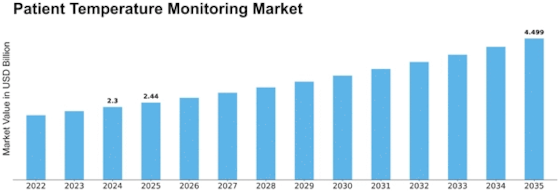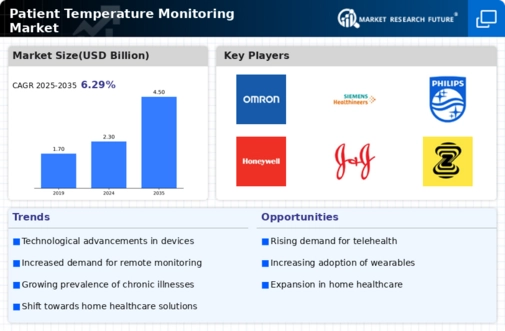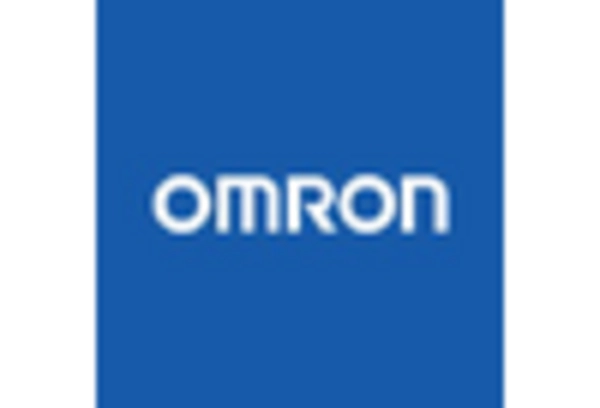Digital Thermometers
Infrared Thermometers
Disposable Thermometers
Electronic Thermometers
Forehead Thermometers
In-ear Thermometers
Oral Thermometers
Rectal Thermometers
Hospitals
Home Care Settings
Ambulatory Surgical Centers
Diagnostic Centers
Online Pharmacies
Retail Pharmacies
Direct Sales
North America
Europe
South America
Asia Pacific
Middle East and Africa
North America Outlook (USD Billion, 2019-2035)
North America Patient Temperature Monitoring Market by Technology Type
Digital Thermometers
Infrared Thermometers
Disposable Thermometers
Electronic Thermometers
North America Patient Temperature Monitoring Market by Product Type
Forehead Thermometers
In-ear Thermometers
Oral Thermometers
Rectal Thermometers
North America Patient Temperature Monitoring Market by End User Type
Hospitals
Home Care Settings
Ambulatory Surgical Centers
Diagnostic Centers
North America Patient Temperature Monitoring Market by Distribution Channel Type
Online Pharmacies
Retail Pharmacies
Direct Sales
North America Patient Temperature Monitoring Market by Regional Type
US
Canada
US Outlook (USD Billion, 2019-2035)
US Patient Temperature Monitoring Market by Technology Type
Digital Thermometers
Infrared Thermometers
Disposable Thermometers
Electronic Thermometers
US Patient Temperature Monitoring Market by Product Type
Forehead Thermometers
In-ear Thermometers
Oral Thermometers
Rectal Thermometers
US Patient Temperature Monitoring Market by End User Type
Hospitals
Home Care Settings
Ambulatory Surgical Centers
Diagnostic Centers
US Patient Temperature Monitoring Market by Distribution Channel Type
Online Pharmacies
Retail Pharmacies
Direct Sales
CANADA Outlook (USD Billion, 2019-2035)
CANADA Patient Temperature Monitoring Market by Technology Type
Digital Thermometers
Infrared Thermometers
Disposable Thermometers
Electronic Thermometers
CANADA Patient Temperature Monitoring Market by Product Type
Forehead Thermometers
In-ear Thermometers
Oral Thermometers
Rectal Thermometers
CANADA Patient Temperature Monitoring Market by End User Type
Hospitals
Home Care Settings
Ambulatory Surgical Centers
Diagnostic Centers
CANADA Patient Temperature Monitoring Market by Distribution Channel Type
Online Pharmacies
Retail Pharmacies
Direct Sales
Europe Outlook (USD Billion, 2019-2035)
Europe Patient Temperature Monitoring Market by Technology Type
Digital Thermometers
Infrared Thermometers
Disposable Thermometers
Electronic Thermometers
Europe Patient Temperature Monitoring Market by Product Type
Forehead Thermometers
In-ear Thermometers
Oral Thermometers
Rectal Thermometers
Europe Patient Temperature Monitoring Market by End User Type
Hospitals
Home Care Settings
Ambulatory Surgical Centers
Diagnostic Centers
Europe Patient Temperature Monitoring Market by Distribution Channel Type
Online Pharmacies
Retail Pharmacies
Direct Sales
Europe Patient Temperature Monitoring Market by Regional Type
Germany
UK
France
Russia
Italy
Spain
Rest of Europe
GERMANY Outlook (USD Billion, 2019-2035)
GERMANY Patient Temperature Monitoring Market by Technology Type
Digital Thermometers
Infrared Thermometers
Disposable Thermometers
Electronic Thermometers
GERMANY Patient Temperature Monitoring Market by Product Type
Forehead Thermometers
In-ear Thermometers
Oral Thermometers
Rectal Thermometers
GERMANY Patient Temperature Monitoring Market by End User Type
Hospitals
Home Care Settings
Ambulatory Surgical Centers
Diagnostic Centers
GERMANY Patient Temperature Monitoring Market by Distribution Channel Type
Online Pharmacies
Retail Pharmacies
Direct Sales
UK Outlook (USD Billion, 2019-2035)
UK Patient Temperature Monitoring Market by Technology Type
Digital Thermometers
Infrared Thermometers
Disposable Thermometers
Electronic Thermometers
UK Patient Temperature Monitoring Market by Product Type
Forehead Thermometers
In-ear Thermometers
Oral Thermometers
Rectal Thermometers
UK Patient Temperature Monitoring Market by End User Type
Hospitals
Home Care Settings
Ambulatory Surgical Centers
Diagnostic Centers
UK Patient Temperature Monitoring Market by Distribution Channel Type
Online Pharmacies
Retail Pharmacies
Direct Sales
FRANCE Outlook (USD Billion, 2019-2035)
FRANCE Patient Temperature Monitoring Market by Technology Type
Digital Thermometers
Infrared Thermometers
Disposable Thermometers
Electronic Thermometers
FRANCE Patient Temperature Monitoring Market by Product Type
Forehead Thermometers
In-ear Thermometers
Oral Thermometers
Rectal Thermometers
FRANCE Patient Temperature Monitoring Market by End User Type
Hospitals
Home Care Settings
Ambulatory Surgical Centers
Diagnostic Centers
FRANCE Patient Temperature Monitoring Market by Distribution Channel Type
Online Pharmacies
Retail Pharmacies
Direct Sales
RUSSIA Outlook (USD Billion, 2019-2035)
RUSSIA Patient Temperature Monitoring Market by Technology Type
Digital Thermometers
Infrared Thermometers
Disposable Thermometers
Electronic Thermometers
RUSSIA Patient Temperature Monitoring Market by Product Type
Forehead Thermometers
In-ear Thermometers
Oral Thermometers
Rectal Thermometers
RUSSIA Patient Temperature Monitoring Market by End User Type
Hospitals
Home Care Settings
Ambulatory Surgical Centers
Diagnostic Centers
RUSSIA Patient Temperature Monitoring Market by Distribution Channel Type
Online Pharmacies
Retail Pharmacies
Direct Sales
ITALY Outlook (USD Billion, 2019-2035)
ITALY Patient Temperature Monitoring Market by Technology Type
Digital Thermometers
Infrared Thermometers
Disposable Thermometers
Electronic Thermometers
ITALY Patient Temperature Monitoring Market by Product Type
Forehead Thermometers
In-ear Thermometers
Oral Thermometers
Rectal Thermometers
ITALY Patient Temperature Monitoring Market by End User Type
Hospitals
Home Care Settings
Ambulatory Surgical Centers
Diagnostic Centers
ITALY Patient Temperature Monitoring Market by Distribution Channel Type
Online Pharmacies
Retail Pharmacies
Direct Sales
SPAIN Outlook (USD Billion, 2019-2035)
SPAIN Patient Temperature Monitoring Market by Technology Type
Digital Thermometers
Infrared Thermometers
Disposable Thermometers
Electronic Thermometers
SPAIN Patient Temperature Monitoring Market by Product Type
Forehead Thermometers
In-ear Thermometers
Oral Thermometers
Rectal Thermometers
SPAIN Patient Temperature Monitoring Market by End User Type
Hospitals
Home Care Settings
Ambulatory Surgical Centers
Diagnostic Centers
SPAIN Patient Temperature Monitoring Market by Distribution Channel Type
Online Pharmacies
Retail Pharmacies
Direct Sales
REST OF EUROPE Outlook (USD Billion, 2019-2035)
REST OF EUROPE Patient Temperature Monitoring Market by Technology Type
Digital Thermometers
Infrared Thermometers
Disposable Thermometers
Electronic Thermometers
REST OF EUROPE Patient Temperature Monitoring Market by Product Type
Forehead Thermometers
In-ear Thermometers
Oral Thermometers
Rectal Thermometers
REST OF EUROPE Patient Temperature Monitoring Market by End User Type
Hospitals
Home Care Settings
Ambulatory Surgical Centers
Diagnostic Centers
REST OF EUROPE Patient Temperature Monitoring Market by Distribution Channel Type
Online Pharmacies
Retail Pharmacies
Direct Sales
APAC Outlook (USD Billion, 2019-2035)
APAC Patient Temperature Monitoring Market by Technology Type
Digital Thermometers
Infrared Thermometers
Disposable Thermometers
Electronic Thermometers
APAC Patient Temperature Monitoring Market by Product Type
Forehead Thermometers
In-ear Thermometers
Oral Thermometers
Rectal Thermometers
APAC Patient Temperature Monitoring Market by End User Type
Hospitals
Home Care Settings
Ambulatory Surgical Centers
Diagnostic Centers
APAC Patient Temperature Monitoring Market by Distribution Channel Type
Online Pharmacies
Retail Pharmacies
Direct Sales
APAC Patient Temperature Monitoring Market by Regional Type
China
India
Japan
South Korea
Malaysia
Thailand
Indonesia
Rest of APAC
CHINA Outlook (USD Billion, 2019-2035)
CHINA Patient Temperature Monitoring Market by Technology Type
Digital Thermometers
Infrared Thermometers
Disposable Thermometers
Electronic Thermometers
CHINA Patient Temperature Monitoring Market by Product Type
Forehead Thermometers
In-ear Thermometers
Oral Thermometers
Rectal Thermometers
CHINA Patient Temperature Monitoring Market by End User Type
Hospitals
Home Care Settings
Ambulatory Surgical Centers
Diagnostic Centers
CHINA Patient Temperature Monitoring Market by Distribution Channel Type
Online Pharmacies
Retail Pharmacies
Direct Sales
INDIA Outlook (USD Billion, 2019-2035)
INDIA Patient Temperature Monitoring Market by Technology Type
Digital Thermometers
Infrared Thermometers
Disposable Thermometers
Electronic Thermometers
INDIA Patient Temperature Monitoring Market by Product Type
Forehead Thermometers
In-ear Thermometers
Oral Thermometers
Rectal Thermometers
INDIA Patient Temperature Monitoring Market by End User Type
Hospitals
Home Care Settings
Ambulatory Surgical Centers
Diagnostic Centers
INDIA Patient Temperature Monitoring Market by Distribution Channel Type
Online Pharmacies
Retail Pharmacies
Direct Sales
JAPAN Outlook (USD Billion, 2019-2035)
JAPAN Patient Temperature Monitoring Market by Technology Type
Digital Thermometers
Infrared Thermometers
Disposable Thermometers
Electronic Thermometers
JAPAN Patient Temperature Monitoring Market by Product Type
Forehead Thermometers
In-ear Thermometers
Oral Thermometers
Rectal Thermometers
JAPAN Patient Temperature Monitoring Market by End User Type
Hospitals
Home Care Settings
Ambulatory Surgical Centers
Diagnostic Centers
JAPAN Patient Temperature Monitoring Market by Distribution Channel Type
Online Pharmacies
Retail Pharmacies
Direct Sales
SOUTH KOREA Outlook (USD Billion, 2019-2035)
SOUTH KOREA Patient Temperature Monitoring Market by Technology Type
Digital Thermometers
Infrared Thermometers
Disposable Thermometers
Electronic Thermometers
SOUTH KOREA Patient Temperature Monitoring Market by Product Type
Forehead Thermometers
In-ear Thermometers
Oral Thermometers
Rectal Thermometers
SOUTH KOREA Patient Temperature Monitoring Market by End User Type
Hospitals
Home Care Settings
Ambulatory Surgical Centers
Diagnostic Centers
SOUTH KOREA Patient Temperature Monitoring Market by Distribution Channel Type
Online Pharmacies
Retail Pharmacies
Direct Sales
MALAYSIA Outlook (USD Billion, 2019-2035)
MALAYSIA Patient Temperature Monitoring Market by Technology Type
Digital Thermometers
Infrared Thermometers
Disposable Thermometers
Electronic Thermometers
MALAYSIA Patient Temperature Monitoring Market by Product Type
Forehead Thermometers
In-ear Thermometers
Oral Thermometers
Rectal Thermometers
MALAYSIA Patient Temperature Monitoring Market by End User Type
Hospitals
Home Care Settings
Ambulatory Surgical Centers
Diagnostic Centers
MALAYSIA Patient Temperature Monitoring Market by Distribution Channel Type
Online Pharmacies
Retail Pharmacies
Direct Sales
THAILAND Outlook (USD Billion, 2019-2035)
THAILAND Patient Temperature Monitoring Market by Technology Type
Digital Thermometers
Infrared Thermometers
Disposable Thermometers
Electronic Thermometers
THAILAND Patient Temperature Monitoring Market by Product Type
Forehead Thermometers
In-ear Thermometers
Oral Thermometers
Rectal Thermometers
THAILAND Patient Temperature Monitoring Market by End User Type
Hospitals
Home Care Settings
Ambulatory Surgical Centers
Diagnostic Centers
THAILAND Patient Temperature Monitoring Market by Distribution Channel Type
Online Pharmacies
Retail Pharmacies
Direct Sales
INDONESIA Outlook (USD Billion, 2019-2035)
INDONESIA Patient Temperature Monitoring Market by Technology Type
Digital Thermometers
Infrared Thermometers
Disposable Thermometers
Electronic Thermometers
INDONESIA Patient Temperature Monitoring Market by Product Type
Forehead Thermometers
In-ear Thermometers
Oral Thermometers
Rectal Thermometers
INDONESIA Patient Temperature Monitoring Market by End User Type
Hospitals
Home Care Settings
Ambulatory Surgical Centers
Diagnostic Centers
INDONESIA Patient Temperature Monitoring Market by Distribution Channel Type
Online Pharmacies
Retail Pharmacies
Direct Sales
REST OF APAC Outlook (USD Billion, 2019-2035)
REST OF APAC Patient Temperature Monitoring Market by Technology Type
Digital Thermometers
Infrared Thermometers
Disposable Thermometers
Electronic Thermometers
REST OF APAC Patient Temperature Monitoring Market by Product Type
Forehead Thermometers
In-ear Thermometers
Oral Thermometers
Rectal Thermometers
REST OF APAC Patient Temperature Monitoring Market by End User Type
Hospitals
Home Care Settings
Ambulatory Surgical Centers
Diagnostic Centers
REST OF APAC Patient Temperature Monitoring Market by Distribution Channel Type
Online Pharmacies
Retail Pharmacies
Direct Sales
South America Outlook (USD Billion, 2019-2035)
South America Patient Temperature Monitoring Market by Technology Type
Digital Thermometers
Infrared Thermometers
Disposable Thermometers
Electronic Thermometers
South America Patient Temperature Monitoring Market by Product Type
Forehead Thermometers
In-ear Thermometers
Oral Thermometers
Rectal Thermometers
South America Patient Temperature Monitoring Market by End User Type
Hospitals
Home Care Settings
Ambulatory Surgical Centers
Diagnostic Centers
South America Patient Temperature Monitoring Market by Distribution Channel Type
Online Pharmacies
Retail Pharmacies
Direct Sales
South America Patient Temperature Monitoring Market by Regional Type
Brazil
Mexico
Argentina
Rest of South America
BRAZIL Outlook (USD Billion, 2019-2035)
BRAZIL Patient Temperature Monitoring Market by Technology Type
Digital Thermometers
Infrared Thermometers
Disposable Thermometers
Electronic Thermometers
BRAZIL Patient Temperature Monitoring Market by Product Type
Forehead Thermometers
In-ear Thermometers
Oral Thermometers
Rectal Thermometers
BRAZIL Patient Temperature Monitoring Market by End User Type
Hospitals
Home Care Settings
Ambulatory Surgical Centers
Diagnostic Centers
BRAZIL Patient Temperature Monitoring Market by Distribution Channel Type
Online Pharmacies
Retail Pharmacies
Direct Sales
MEXICO Outlook (USD Billion, 2019-2035)
MEXICO Patient Temperature Monitoring Market by Technology Type
Digital Thermometers
Infrared Thermometers
Disposable Thermometers
Electronic Thermometers
MEXICO Patient Temperature Monitoring Market by Product Type
Forehead Thermometers
In-ear Thermometers
Oral Thermometers
Rectal Thermometers
MEXICO Patient Temperature Monitoring Market by End User Type
Hospitals
Home Care Settings
Ambulatory Surgical Centers
Diagnostic Centers
MEXICO Patient Temperature Monitoring Market by Distribution Channel Type
Online Pharmacies
Retail Pharmacies
Direct Sales
ARGENTINA Outlook (USD Billion, 2019-2035)
ARGENTINA Patient Temperature Monitoring Market by Technology Type
Digital Thermometers
Infrared Thermometers
Disposable Thermometers
Electronic Thermometers
ARGENTINA Patient Temperature Monitoring Market by Product Type
Forehead Thermometers
In-ear Thermometers
Oral Thermometers
Rectal Thermometers
ARGENTINA Patient Temperature Monitoring Market by End User Type
Hospitals
Home Care Settings
Ambulatory Surgical Centers
Diagnostic Centers
ARGENTINA Patient Temperature Monitoring Market by Distribution Channel Type
Online Pharmacies
Retail Pharmacies
Direct Sales
REST OF SOUTH AMERICA Outlook (USD Billion, 2019-2035)
REST OF SOUTH AMERICA Patient Temperature Monitoring Market by Technology Type
Digital Thermometers
Infrared Thermometers
Disposable Thermometers
Electronic Thermometers
REST OF SOUTH AMERICA Patient Temperature Monitoring Market by Product Type
Forehead Thermometers
In-ear Thermometers
Oral Thermometers
Rectal Thermometers
REST OF SOUTH AMERICA Patient Temperature Monitoring Market by End User Type
Hospitals
Home Care Settings
Ambulatory Surgical Centers
Diagnostic Centers
REST OF SOUTH AMERICA Patient Temperature Monitoring Market by Distribution Channel Type
Online Pharmacies
Retail Pharmacies
Direct Sales
MEA Outlook (USD Billion, 2019-2035)
MEA Patient Temperature Monitoring Market by Technology Type
Digital Thermometers
Infrared Thermometers
Disposable Thermometers
Electronic Thermometers
MEA Patient Temperature Monitoring Market by Product Type
Forehead Thermometers
In-ear Thermometers
Oral Thermometers
Rectal Thermometers
MEA Patient Temperature Monitoring Market by End User Type
Hospitals
Home Care Settings
Ambulatory Surgical Centers
Diagnostic Centers
MEA Patient Temperature Monitoring Market by Distribution Channel Type
Online Pharmacies
Retail Pharmacies
Direct Sales
MEA Patient Temperature Monitoring Market by Regional Type
GCC Countries
South Africa
Rest of MEA
GCC COUNTRIES Outlook (USD Billion, 2019-2035)
GCC COUNTRIES Patient Temperature Monitoring Market by Technology Type
Digital Thermometers
Infrared Thermometers
Disposable Thermometers
Electronic Thermometers
GCC COUNTRIES Patient Temperature Monitoring Market by Product Type
Forehead Thermometers
In-ear Thermometers
Oral Thermometers
Rectal Thermometers
GCC COUNTRIES Patient Temperature Monitoring Market by End User Type
Hospitals
Home Care Settings
Ambulatory Surgical Centers
Diagnostic Centers
GCC COUNTRIES Patient Temperature Monitoring Market by Distribution Channel Type
Online Pharmacies
Retail Pharmacies
Direct Sales
SOUTH AFRICA Outlook (USD Billion, 2019-2035)
SOUTH AFRICA Patient Temperature Monitoring Market by Technology Type
Digital Thermometers
Infrared Thermometers
Disposable Thermometers
Electronic Thermometers
SOUTH AFRICA Patient Temperature Monitoring Market by Product Type
Forehead Thermometers
In-ear Thermometers
Oral Thermometers
Rectal Thermometers
SOUTH AFRICA Patient Temperature Monitoring Market by End User Type
Hospitals
Home Care Settings
Ambulatory Surgical Centers
Diagnostic Centers
SOUTH AFRICA Patient Temperature Monitoring Market by Distribution Channel Type
Online Pharmacies
Retail Pharmacies
Direct Sales
REST OF MEA Outlook (USD Billion, 2019-2035)
REST OF MEA Patient Temperature Monitoring Market by Technology Type
Digital Thermometers
Infrared Thermometers
Disposable Thermometers
Electronic Thermometers
REST OF MEA Patient Temperature Monitoring Market by Product Type
Forehead Thermometers
In-ear Thermometers
Oral Thermometers
Rectal Thermometers
REST OF MEA Patient Temperature Monitoring Market by End User Type
Hospitals
Home Care Settings
Ambulatory Surgical Centers
Diagnostic Centers
REST OF MEA Patient Temperature Monitoring Market by Distribution Channel Type
Online Pharmacies
Retail Pharmacies
Direct Sales


















Leave a Comment